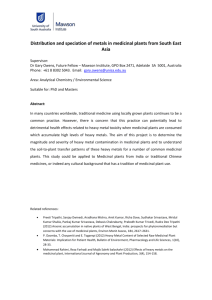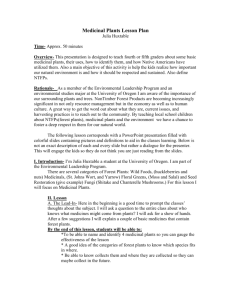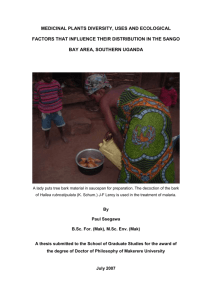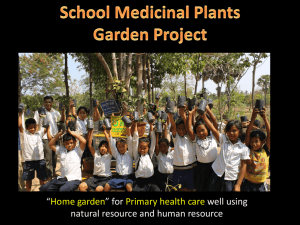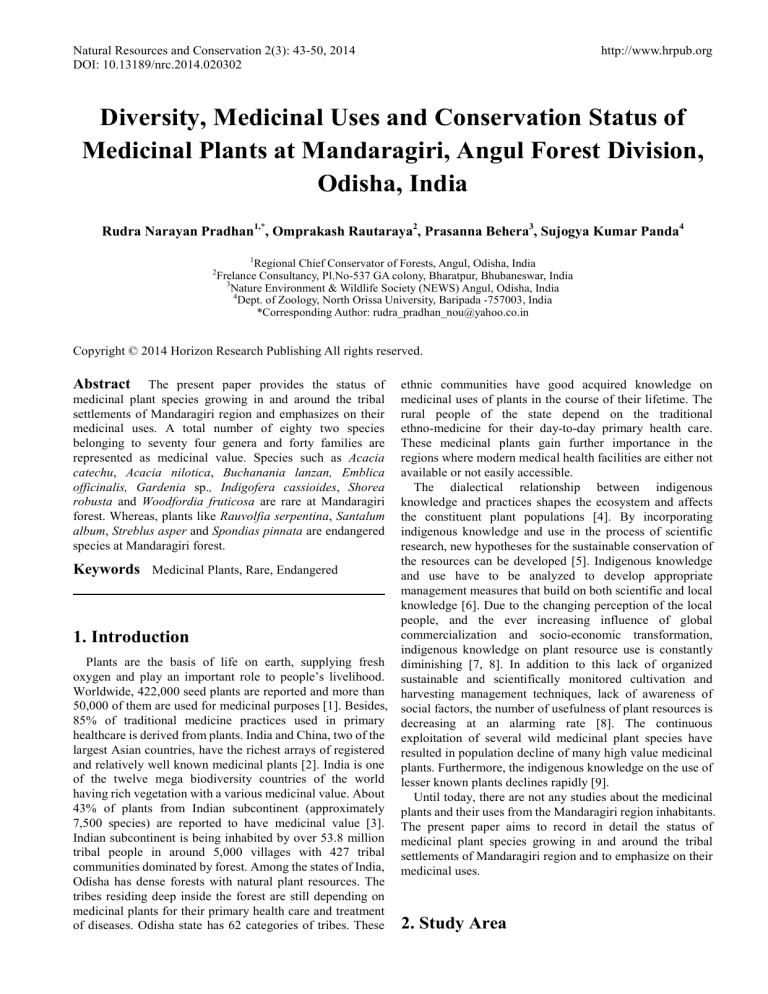
Natural Resources and Conservation 2(3): 43-50, 2014
DOI: 10.13189/nrc.2014.020302
http://www.hrpub.org
Diversity, Medicinal Uses and Conservation Status of
Medicinal Plants at Mandaragiri, Angul Forest Division,
Odisha, India
Rudra Narayan Pradhan1,*, Omprakash Rautaraya2, Prasanna Behera3, Sujogya Kumar Panda4
1
Regional Chief Conservator of Forests, Angul, Odisha, India
Frelance Consultancy, Pl.No-537 GA colony, Bharatpur, Bhubaneswar, India
3
Nature Environment & Wildlife Society (NEWS) Angul, Odisha, India
4
Dept. of Zoology, North Orissa University, Baripada -757003, India
*Corresponding Author: rudra_pradhan_nou@yahoo.co.in
2
Copyright © 2014 Horizon Research Publishing All rights reserved.
Abstract
The present paper provides the status of
medicinal plant species growing in and around the tribal
settlements of Mandaragiri region and emphasizes on their
medicinal uses. A total number of eighty two species
belonging to seventy four genera and forty families are
represented as medicinal value. Species such as Acacia
catechu, Acacia nilotica, Buchanania lanzan, Emblica
officinalis, Gardenia sp., Indigofera cassioides, Shorea
robusta and Woodfordia fruticosa are rare at Mandaragiri
forest. Whereas, plants like Rauvolfia serpentina, Santalum
album, Streblus asper and Spondias pinnata are endangered
species at Mandaragiri forest.
Keywords Medicinal Plants, Rare, Endangered
1. Introduction
Plants are the basis of life on earth, supplying fresh
oxygen and play an important role to people’s livelihood.
Worldwide, 422,000 seed plants are reported and more than
50,000 of them are used for medicinal purposes [1]. Besides,
85% of traditional medicine practices used in primary
healthcare is derived from plants. India and China, two of the
largest Asian countries, have the richest arrays of registered
and relatively well known medicinal plants [2]. India is one
of the twelve mega biodiversity countries of the world
having rich vegetation with a various medicinal value. About
43% of plants from Indian subcontinent (approximately
7,500 species) are reported to have medicinal value [3].
Indian subcontinent is being inhabited by over 53.8 million
tribal people in around 5,000 villages with 427 tribal
communities dominated by forest. Among the states of India,
Odisha has dense forests with natural plant resources. The
tribes residing deep inside the forest are still depending on
medicinal plants for their primary health care and treatment
of diseases. Odisha state has 62 categories of tribes. These
ethnic communities have good acquired knowledge on
medicinal uses of plants in the course of their lifetime. The
rural people of the state depend on the traditional
ethno-medicine for their day-to-day primary health care.
These medicinal plants gain further importance in the
regions where modern medical health facilities are either not
available or not easily accessible.
The dialectical relationship between indigenous
knowledge and practices shapes the ecosystem and affects
the constituent plant populations [4]. By incorporating
indigenous knowledge and use in the process of scientific
research, new hypotheses for the sustainable conservation of
the resources can be developed [5]. Indigenous knowledge
and use have to be analyzed to develop appropriate
management measures that build on both scientific and local
knowledge [6]. Due to the changing perception of the local
people, and the ever increasing influence of global
commercialization and socio-economic transformation,
indigenous knowledge on plant resource use is constantly
diminishing [7, 8]. In addition to this lack of organized
sustainable and scientifically monitored cultivation and
harvesting management techniques, lack of awareness of
social factors, the number of usefulness of plant resources is
decreasing at an alarming rate [8]. The continuous
exploitation of several wild medicinal plant species have
resulted in population decline of many high value medicinal
plants. Furthermore, the indigenous knowledge on the use of
lesser known plants declines rapidly [9].
Until today, there are not any studies about the medicinal
plants and their uses from the Mandaragiri region inhabitants.
The present paper aims to record in detail the status of
medicinal plant species growing in and around the tribal
settlements of Mandaragiri region and to emphasize on their
medicinal uses.
2. Study Area
44
Diversity, Medicinal Uses and Conservation Status of Medicinal Plants at Mandaragiri,
Angul Forest Division, Odisha, India
The Mandaragiri forest lies between 200 47’ 15’’ and 200
49’ 00’’ north latitude and 850 1’ 30’’ and 850 3’ 30’’ east
longitude in the district of Angul, Odisha, India. The
Mandaragiri forest is a unique fragile ecosystem covering
586 hectares of forest land (Figures 1 & 2). The whole
mountain was covered with dense forest but due to lack of
protection, a rapid, large scale felling of trees occurred since
1970, diminishing the forest cover. In 1995, the people of the
surrounding nine villages formed the Mandaragiri
Surakshya Manch in order to protect the forest. Now the
mountain boasts a thick sprawling green and many useful
plants. Inhabitants around Mandaragiri hill are attached to it
and have a basic natural feeling for its conservation due to
different religious beliefs and mythological reasons. The
climate of Mandaragiri is warm and humid. Summer months
are very hot with maximum day temperatures 45- 47°C in the
months of May and June which drops sensibly with the onset
of the monsoon. When the monsoon withdraws in October,
the daytime temperature remains the same however the
nights become cooler. Gradually, both day and night
temperatures fall. The coolest month is December when
temperature at night varies between 6°C and 11°C. Relative
humidity is maximum in October and minimum in April and
May.
3. Materials and Methods
Field study (16 trip) was conducted from time to time
during both winter and summer to generate the information’s
by contacting village medicine men and Kavirajs (Vaidyas).
They were interviewed to record different plants used in
primary healthcare system for various remedies . The spot
identification of medicinal plants was done with the help of
local experts and published floras [10]. Fresh samples of
species which could not been identified were brought to the
institution and identified in the laboratory. The diversity and
place of distribution was recorded. Nativity and endemism
were identified based on the distribution of the species.
To establish the uses of the medicinal plants literature was
composed from the earlier published books by Kirtikar et al.
[11-13]. In the following tabulation, the plant names have
been arranged alphabetically accordingly their botanical
names.
4. Results
A Total number of 82 species belonging to 74 genera and
40 families were recorded. Fabaceae (9 species);
Anacardiaceae (5); Mimosaceae (5); Moraceae (5);
Apocynaceae (4); Caesalpiniaceae (4); Combretaceae (4)
and Verbenaceae (4) are the dominated families. Ficus sp.,
Terminalia sp. and Acacia sp. are the dominated genera.
Among the medicinal plants Anogeissus latifolia, Gmelina
arborea, Madhuca longifolia, Pterocarpus marsupium,
Shorea robusta, and Terminalia bellirica are high value
species exploited for different purposes. Species such as
Acacia catechu, Acacia nilotica, Buchanania lanzan,
Emblica officinalis, Gardenia sp., Indigofera cassioides,
Shorea robusta and Woodfordia fruticosa are rare at
Mandaragiri forest. Whereas, plants like Rauvolfia
serpentina, Santalum album, Streblus asper and Spondias
pinnata are endangered species at Mandaragiri forest. (Table
1).
Figure 1. Map of OdishaIndia showing Mandaragiri forest
Natural Resources and Conservation 2(3): 43-50, 2014
45
Figure 2. Map of the Mandaragiri forest
Table 1. Important ethno-medicinal plants of Mandaragiri forest
Botanical Name
Family
Local Name
Status of
Finding
Place of
distribution
Parts
Used
Rt, Lf ,
Sd.
Abrus pracatorius L.
Fabaceae
Kaincha
MQ
V
Acacia nilotica (l.)
Willd. ex Delile sp.
indica
Mimosaceae
Babul
CF
FH
Bk, gum
Acacia catechu
Mimosaceae
Khair
MQ
E
Bk , Hw
Acacia leucophloea
(Roxb.) Willd.
Mimosaceae
Gohira
R
FH
Bk
Achyranthes aspera
L.
Amaranthaceae
Apama-ranga
CF
E
Wp
Aegle marmelos (L.)
Corr. Serr.
Rutaceae
Bela
CF
E
Rt, Lf,
Fr
Ageratum conyzoides
L.
Asteraceae
Poksungha
CF
E
Rt , Lf
Albizia lebbek
Mimosaceae
Siris
R
E
Bk, Fl,
Sd
Alstonia scholaris
(L.) R.Br
Apocynaceae
Chhatian
R
FH
Bk , Lf
Andrographis
paniculata (Burm.f.)
Wall. ex Nees
Acanthaceae
Bhuinnimba
CF
E
Wp
Medicinal Properties
Leucoderma, skin diseases asthma and
fever.
Haemostatic, antipyretic, asthma,
diarrhea
Anti-dysenteric, haemostatic, leprosy,
leucoderma
Thermogenic, constipating, antipyretic,
used in cough, bronchitis, leprosy,
vomiting and ulcers
Useful in cough, asthma, bronchitis, colic
and cardiac disorder.
Useful in diarrhea and dysentery, seminal
weakness, gastric, diabetes and asthmatic
complaints
Used in cough, wound infection and eye
lotion.
Used in catarrh, asthma, leprosy,
leucoderma, sprain, wounds and ulcers.
Useful in preparation of cardio-tonic and
abdominal disorder, diarrhea, dysentery
and cardiopathy.
Wounds, ulcers, chronic fever, malaria,
skin diseases, and intestinal worms.
46
Diversity, Medicinal Uses and Conservation Status of Medicinal Plants at Mandaragiri,
Angul Forest Division, Odisha, India
Anogeissus latifolia
(Roxb.)
Wall. ex Bedd.
Combretaceae
Dhaura
R
E
Rt, Bk,
Lf , Sd
Argemone mexicana
L.
Papaveraceae
Ganghauda
R
FH
Wp
Asparagus
racemosus Willd.
Liliaceae
Satabari
R
E
Rt
Azadirachta indica
A. Juss.
Meliaceae
Neem
R
E
Bk, Lf,
Sd , oil
Bacopa monnieri
Scrophulariaceae
Brahmi
MQ
V
Wp
Bambusaceae
Kanta baunsa
CF
S
Rt, Lf
Caesalpinaceae
Kanchana
R
E
Rt , Bk.
Bombax ceiba L.
Bombacaceae
Semul
R
E
Rt, gum,
Bk , Fr.
Buchanania lanzan
Spreng.
Anacardiaceae
Char
CF
E
Rt , Fr
Calotropis gigantea
R.Br.
Asclepiadaceae
Arakha
MQ
FH
Wp
Careya arborea
Roxb.
Barriangtoniaceae
Kumbhi
R
E
Bk, Lf ,
Fr
Cassia fistula L.
Caesalpiniaceae
Sunari
R
E
Wp
Cassia tora L.
Caesalpiniaceae
Chakunda
R
FH
Lf , Sd
Clitoria ternatea L.
Fabaceae
Aparajita
CF
MH
Rt, Lf ,
Sd
Curcuma aromatica
Salisb
Zingiberaceae
Bana haladi
CF
V
Rh
Cuscuta reflexa
Convolvulaceae
Nirmuli
R
FH
Wp
Cynodon dactylon
(L.) Pers.
Poaceae
Duba ghassa
CF
E
Wp
Dalbergia sissoo
Fabaceae
Sissoo
R
E
Rt, Lf,
Bk , Hw
Datura metel L.
Solanaceae
Dudura
CF
FH
Wp
Desmodium
gangeticum (L.) DC.
Fabaceae
Salaparni
CF
E
Rt
Emblica officinalis
Gaertn.
Euphorbiaceae
Anla
CF
E
Rt, Bk,
Lf , Fr
Ficus bengalensis L.
Moraceae
Bara
CF
E
Rt, Bk,
Lf, lt
Ficus microcarpa
L.f.
Moraceae
Jari
R
HT
Rt, Bk ,
Lf
Ficus racemosa L.
Moraceae
Dimiri
R
HT
Bk , Fr
Ficus religiosa L.
Moraceae
Aswasthha
R
E
Bk, Fr ,
Bambusa
arundianacea
Bauhinia variegata
L.
Haemostatic, useful in skin diseases,
diarrhea and dysentery.
Antipyretic, sedative, aphrodisiac, used in
asthma, skin diseases, wounds and ulcers,
latex is used in jaundice and malaria
fever.
Useful in nervous disorder, diarrhea,
dysentery, throat infections, tuberculosis
and epilepsy, cardiac debility
hypertension and abortion.
Useful in the cure of cough, skin diseases,
eczema, leucoderma, malaria, bronchitis
and diabetes.
Intellect promoting, anticonvulsant,
cardio tonic, useful in epilepsy and
insanity.
Skin diseases, ringworm, diarrhea,
gonorrhoea.
Useful in skin diseases, leprosy, intestinal
worms, wounds and ulcers.
Paste is good for skin eruptions, fruits
useful in ulceration of bladder and kidney.
Skin diseases, seminal weakness, cardio
tonic, nervous debility and cardiac
debility.
Febrifuge and laxative. Promotes gastric
secretions. Useful for asthma, paralysis.
Thermogenic and antipyretic. Useful for
tumours. colic, intestinal worms, epileptic
fits and healing of vaginal ruptures.
Useful in skin diseases, tuberculosis,
syphilis, diabetes, leprosy and ring worm.
Thermogenic, laxative, liver tonic, cardio
tonic.
Useful in leprosy and leucoderma
treatment
Useful in the treatment of bruises, sprains,
bronchitis, cough, leucoderma and skin
eruptions.
Useful in jaundice, cough, bronchitis and
paralysis.
Haemostatic, useful in the treatment of
skin diseases, vomiting, diarrhea,
dysentery and abortion.
Thermogenic, aphrodisiac and
antipyretic. Useful in the treatment of skin
diseases, leucoderma, scabies, ulcers,
syphilis, gastropathy and
ophthalmopathy.
Narcotic, antispasmodic, intoxicant.
Useful in asthma, fever, ulcers and skin
diseases. Also used to treat dog bite.
Febrifuge, thermogenic, nervine tonic,
cardio tonic.
Aphrodisiac, antipyretic, digestive.
Useful for diabetes, asthma, peptic ulcers,
anaemia and emaciation.
Useful in the treatment of diarrhea,
dysentery, diabetes, ulcers, skin diseases,
gonorrhoea, rheumatism.
Useful in the treatment of wounds, ulcers,
diabetes, diarrhea and dysentery.
Useful in ulcers, leucoderma, anaemia,
jaundice and dysentery.
Aphrodisiac, antibacterial and purgative.
Natural Resources and Conservation 2(3): 43-50, 2014
Sd
Flacourtiaceae
Kanteikuli
CF
E
Rt, Lf ,
Fr
Rubiaceae
Ghurudu
EX
HT
Resin
Verbenaceae
Gambhari
R
HT
Wp
Helicteres isora L.
Sterculiaceae
Mudmudi
CF
E
Rt, Bk ,
Fr
Hemidesmus indicus
(L.) R.Br.
Asclepiadaceae
Anantamula
CF
E
Rt, Lf,
St
Holarrhena
antidysenterica Wall
ex. A.DC.
Apocynaceae
Kurein
CF
E
Bk, Sd ,
Lf
Ichnocarpus
frutescens (L.) R.Br.
Apocynaceae
Soyamlai
CF
E
Rt
Indigofera cassioides
Rottl. ex DC.
Fabaceae
Nil
R
E
Wp
Anacardiaceae
Mai
CF
E
Bk , Lf
Verbenaceae
Lantana (Naga
Airi)
CF
FH
Wp
Lamiaceae
Gayasha
R
FH
Lf, Fl
Rutaceae
Kainthha
MQ
HT
Sapotaceae
Mohul
R
FH
Mangifera indica L.
Anacardiaceae
Amba
R
FH
Melia composite
Willd.
Meliaceae
Mohalimba
R
S
Wp
Mimosa pudica L.
Mimosaceae
Lajkuli
CF
E
Rt , Lf
Morinda tinctoria
Roxb. non Noronha
Rubiaceae
Anchhu
CF
E
Rt , Lf
Mucuna pruriens (L.)
DC
Fabaceae
Baidanka
CF
E
Rt, Lf,
Sd
Nyctanthes
arbortristis L.
Oleaceae
Gangasiuli
CF
E
Lf, Fl,
Sd
Lamiaceae
Banatulasi
CF
E
Lf , Sd
Fabaceae
Bandhan
EN
V
Bk
Asclepiadaceae
Uturudi
R
FH
Wp
Arecaceae
Banakhajuri
CF
FH
Fr
Pterocarpus
marsupium Roxb.
Fabaceae
Piasal
R
V
Hw ,
gum
Rauvolfia serpentina
(L.) Benth.ex Kurz.
Apocynaceae
Patal garuda
EN
V
Rt , Lf
Santalum album L.
Santalaceae
Chandan
EN
FH
Hw , Rt
Flacourtia indica
Gardenia gummifera
L.f.
Gmelina arborea
Roxb.
Lannea
coromondelica
(Houtt,) Merr.
Lantana camara auct.
non L.
Leucas indica (L.) R.
Br. ex Vatke
Limonia acidissima
L.
Madhuca longifolia
(Koenig) Macbride
Ocimum americanum
L.
Ougeinia oojeinensis
Roxb.
Pergularia daemia
(Forsk.) Chiov.
Phoenix sylvestris
(L.) Roxb.
Bk, Fr ,
gum
Bk, Fr ,
Sd
Rt, Bk,
Sd
47
Useful in skin infection.
Useful in the treatment snake bite, skin
diseases. Fruits are appetizer and
digestive.
Thermogenic, antispasmodic,
cardio-tonic. Useful in intestinal worms.
Useful in fever, dyspepsia, skin diseases
and promoting the growth of hair.
Lactifuge, demulcent. Useful in colic,
scabies, diabetes and gastropathy.
Aphrodisiac, demulcent, febrifuge,
Useful in asthma, bronchitis, leucoderma,
leprosy, epileptic fits.
Aphrodisiac, digestive and febrifuge.
Useful in amoebic dysentery, diarrhea,
asthma, skin diseases and chronic
bronchitis.
Seminal weakness, fever, skin diseases
and diabetes.
Thermogenic, laxative. Useful for
promoting the growth of hair, cardiopathy
and neuropathy.
Useful in treatment of wounds, bruises,
ulcers and sprains.
Antispasmodic. Useful in malaria,
epilepsy and gastropathy.
Thermogenic, antipyretic. Leaf juice is
used as eye and nasal drop during
infection.
Cardio tonic.Useful in gastropathy,
diarrhea, vomiting, bronchitis.
Useful for epilepsy, sprains and
rheumatism.
Useful for syphilis, wounds, ulcers, and
rheumatism.
Asthma, diabetes, fevers, after delivery,
hysteria, cardiac diseases and typhoid
fever.
Antispasmodic, Febrifuge, Useful in
leucoderma, jaundice, asthma, small pox
and uterus infection.
Useful in gastric disorder and diarrhea.
Thermogenic, stimulant, purgative.
Leaves are aphrodisiac. They are useful in
gonorrhoea and sterility.
Thermogenic, antibacterial and febrifuge.
Useful in malaria, chronic fever and
grayness of hair and baldness.
Useful in parasite infection and poisonous
bites, malarial fever.
Stimulant and rejuvenating. Useful in
diabetes, gonorrhoea and anaemia.
Useful in uterine and menstrual disorder.
Cardio tonic and aphrodisiac. Useful in
seminal weakness and general debility.
Rejuvenating and union promoter. Useful
in fractures, bruises, skin diseases,
leucoderma, diabetes. gum is used as liver
tonic.
Useful for hypertension, insomnia,
epilepsy.
Intellect promoting, cardio-tonic.
haemostatic, aphrodisiac. Useful in
48
Diversity, Medicinal Uses and Conservation Status of Medicinal Plants at Mandaragiri,
Angul Forest Division, Odisha, India
Schleichera oleosa
(Lour.) Oken
Sapindaceae
Kusum
CF
E
Bk , oil
Semecarpus
anacardium L.f.
Anacardiaceae
Bhalia
R
E
Fr
Sesbania grandiflora
(L.) Poiret
Fabaceae
Agasti
R
S
Rt, Bk,
Lf, Fl, Fr
Shorea robusta
Gaertn.f.
Dipterocarpaceae
Sal
R
FH
Bk, Fr
Solanum surattense
Burm. f.
Solanoceae
Ankaranti
CF
FH
Wp
Spondias pinnata
(L.f.) Kurz
Anacardiaceae
Ambada
EN
Above FH
Streblus asper Lour.
Moraceae
Sahada
EN
E
Syzygium cumini (L.)
Skeels
Myrtaceae
Jamu
R
E
Tamarindus indica L.
Caesalpiniaceae
Tentuli
R
E
Tectona grandis L.f.
Verbenaceae
Saguan
MQ
Combretaceae
Bahada
CF
E
Bk , Fr
Combretaceae
Harida
CF
E
Fr
Combretaceae
Asan
CF
E
Bk
Tragia involucrate L.
Euphorbiaceae
Bichhuati
CF
E
Rt , Lf
Trichosanthes
anguina
Cucurbitaceae
Mohakal
R
E
Rt , Fr
Vitex negundo L.
Verbenaceae
Begunia
R
FH
Wp
Vitis quadrangularis
Wall. ex Lawson
Vitaceae
Hadabh-anga
MQ
E
Wp
Woodfordia fruticosa
(L.) Kurz.
Lythraceae
Dhatki
CF
E
Fl
Ziziphus mauritiana
Lam.
Rhamnaceae
Barakoli
CF
E
Wp
Terminalia bellirica
(Gaertn.) Roxb.
Terminalia chebula
Retz.
Terminalia
tomentosa Wight &
Arn.
FH
Rt, Bk,
Fr, Sd
Rt, Bk,
Lf , latex
Bk, Lf ,
Fr
Rt, Fr ,
Sd
Wp
psychopathy, cardiac debility, gastric
irritability and hyper acidity.
Bark used for malaria, ripening boils, seed
oil used for burns and ulcers.
Digestive, purgative, liver tonic stimulant,
antiseptic, uterine stimulant. Useful in
cancer, diabetes and tumor.
Febrifuge. Useful for nasal infection.
Useful in bacterial infection, tuberculosis,
ulcers, Seminal weakness and burning of
eyes.
Digestive, febrifuge, stimulant, skin
diseases. hypertension, cough,asthma,
epilepsy, cardiac disorder.
Thermogenic, appetizer and aphrodisiac.
Useful in muscular rheumatism.
Useful in cough, ulcers, bronchitis, throat
infection.
Useful in diabetes and strengthening the
teeth, gums, ring worms.
Thermogenic, anti-fungal, jaundice,
scabies, ringworm, small pox and
diabetes.
Useful in hyper acidity, diabetes, leprosy,
skin diseases.
Useful in anaemia, leucoderma, narcotic,
digestive, antipyretic.
Purgative, Digestive, Cardio tonic. Useful
in throat infection .
Cardio tonic. Useful in throat infection
wounds, ulcers, diarrhea and dysentery.
Venereal diseases, diabetes and blood
prifier.
Useful in asthma, ophthalmia epilepsy
and leprosy.
Antiseptic, antipyretic, ophthalmic,
general debility, sprains and cardiac
disorder.
Used in treatment of fractures, swellings,
powdered roots and stem paste are used in
specifically for bone fractures.
Stimulant, antibacterial corrective of
urinary pigments, and diabetes.
Aphrodisiac and invigorating. Useful in
the treatment of boils, wounds, syphilis,
ulcers, typhoid fever..
Note: CF= commonly found, R =Rare, MQ= Medium quantity, EN = Endangered, EX= Extinct, S=Slope areas, MH=Middle of Hills, V=Valley, HT=Hill
Top, FH=Foot Hill, E=Every where, Fl-flower; Fr-fruit; Lf-leaf; Bk-bark; Rt-root; Rh-rhizome; St-stem; Sd-seeds; Wp-whole plant
Local users rely on subsistence agriculture; with plants
performing vital roles as crops, fodders, fruits and vegetables,
fuel wood, building materials and medicines. Moreover,
some plant species have religious value; some are used for
construction as timber, while many of them are used for
edible purpose. Local users use plant parts such as bark, root,
leaf, seed, flower, fruit or entire plant for medicinal purpose
to cure their different nature of ailments. People rely on
plant-based medicines for primary health care against
stomachache, diarrhea, bacillary dysentery, colic dysentery,
constipation, digestion problem, gastric, stomach pain,
rheumatic problems, respiratory problems such as cough,
cold, bronchitis, asthma, tuberculosis, fever, skin diseases
and bone fracture.
5. Discussion
Plants are of utmost interest to the human race and our
ancestors lived on nuts, roots, succulent stems, fruits and
other parts of plants. Today, our existence can still not be
imagined without plants. The Mandaragiri forest support a
number of plant species, most of which have useful values.
Local people are based on agriculture supported by animal
Natural Resources and Conservation 2(3): 43-50, 2014
husbandry and dependent upon the forest resources around
them for a number of daily requirements such as fodder, fuel
wood, medicine, food, and fiber, raw material for handicrafts,
house construction and agricultural tools. Most of the
identified plants reported here have multiple local uses.
Some commercially important plant species such as
Anogeissus latifolia, Gmelina arborea, Madhuca longifolia,
Pterocarpus marsupium, Shorea robusta, Terminalia arjuna
and Terminalia bellirica have also medicinal value. Some
wild food plants viz Buchanania, Flacourtia, Spondias etc.
have medicinal properties and in other parts of the country
are well known for their edible.
Aegle marmelos, Ocimmum americanum,Achyranthes
aspera, Calotropis gigantea, Ficus bengalensis, Emblica
officinalis. Semecarpus anacardium and Mangifera indica
are regarded for religious purpose along with their medicinal
value and other domestic uses, and found to be well
conserved by the tribal people.
Considering that the demand for medicinal plants is
increasing, their survival in their natural habitat is under
growing threat. This is due to over-harvesting, rapid
degradation and loss of natural habitats. Thirty five
medicinal plant species are critically threatened in Odisha
state. Species such as Acacia catechu, Acacia nilotica,
Buchanania lanzan, Emblica officinalis, Gardenia sp.,
Indigofera cassioides, Shorea robusta and Woodfordia
fruticosa are rare, while, plants like Rauvolfia serpentina,
Santalum album, Streblus asper and Spondias pinnata are
endangered species at Mandaragiri forest.
Today, it is estimated that about 1,000 species of
medicinal plants are facing threat to their existence, and
some of them have become extinct in the wild. The
Mandragiri forest constitutes a vast treasure of diverse
medicinal plants. Many of the identified medicinal species
and many more are yet to be identified may exist from
Mandragiri. Therefore, steps must be taken for their
identification and conservation both by ex-situ and in-situ
means.In order to protect the biological diversity following
measures are advise for conservation purpose viz. (i) In-situ
conservation of wild population in forests and other in-situ
habitats like sacred grooves and community forests; (ii)
Establishment of herbal gardens to conserve representative
populations of medicinal plants (iii) Establishment of several
home gardens to conserve intra-specific diversity of plants
useful for human and livestock health; (iv) Large scale
organic cultivation of selected cultivars of medicinal plants.
Many authors have advocated the involvement of local
people in the protection of natural resources, such as forests
and wildlife. So, involvement of local peoples can also play a
major role in the conservation with following ways- (i)
Generate and share information regarding species of
medicinal and economic importance and conservation
concern; (ii) Promote awareness of the concerns and policies
tribes and other groups that safe guard traditional knowledge
of native medicinal plants as these pertain to confidentially
of information; (iii) Encourage active participation by tribes
and other holders of traditional ecological knowledge
49
pertaining to native medicinal plants; and (iv) Conserve
indigenous plants and plant communities used in traditional
medicines, ceremony, ethnobotany and the natural products
industry.
6. Conclusion
The present study indicates that Mandaragiri forest
harbors a high diversity of useful plants. The inhabitants are
dependent on folk medicine due to poverty and the
traditional belief of its effectiveness. Documentation of
availability of medicinal plants has provided useful
information. Further ethno-medicinal studies are required
from this area, as tribes have a strong belief in the efficacy
and success of herbal medicine and traditional healing
practices among them. Therefore, it is essential to conserve
such a wealth of information hidden among the local people.
Acknowledgements
Authors are grateful to the Mr. Pandab Behera, IFS, RCCF,
Angul and Vinod Kumar, IFS, PD, OFSD for allowing
permission for this study. Thanks are due to forest staff and
tribal who cooperated in sharing their knowledge during the
study.
REFERENCES
[1]
R Govaerts. How many species of seed plants are there?
Taxon, vol. 50(4), 1085-1090, 2001.
[2]
PH Raven. Medicinal plants and global sustainability: The
canary in the coal mine. In Medicinal Plants: A Global
Heritage, Proceedings of the International conference on
medicinal plants for survival, New Delhi: International
Development Research Center, 14-18, 1998.
[3]
P Pushpangadan. Ethnobiology of India: A Status Report,
GOI, New Delhi, 1995.
[4]
SK Ghimire, D McKey, Y Aumeeruddy-Thomas.
Heterogeneity in ethnoecological knowledge and
management of medicinal plants in the Himalayas of Nepal:
implications for conservation. Ecology and Society, vol. 9(3):
6, 2004.
[5]
TB Henfrey. Ethnoecology, Resource Use, Conservation and
Development in a Wapishana Community in the South
Rupununi Guyana. (PhD thesis) University of Kent, UK,
2002.
[6]
T Ticktin, T Johns. Chinanteco management of Aechmea
magdalenae: implications for the use of traditional ecological
knowledge and traditional resource management in
management plans. Economic Botany, vol. 56(2), 117-191,
2002.
[7]
M Gadgil, F Berkes, C Folke-. Indigenous knowledge of
biodiversity conservation. Ambio, vol. 22(2-3), 151-156,
50
Diversity, Medicinal Uses and Conservation Status of Medicinal Plants at Mandaragiri,
Angul Forest Division, Odisha, India
1993.
[8]
[9]
RM Kunwar, N Adhikari. Ethnomedicine of Dolpa district,
Nepal: the plants, their vernacular names and uses. Lyonia,
vol. 8(1), 41-47, 2005.
CP Kala. Current status of medicinal plants used by
traditional Vaidyas in Uttaranchal- State of India.
Ethnobotany Research and Applications, 3, 267-278, 2005.
[10] HH Haines. The Botany of Bihar and Orissa. London.
(Reprint, 1961, Calcutta), 1921-1925.
[11] KR Kirtikar, BD Basu, ICG An. Indian Medicinal Plants, Vol.
II. Edited & rewritten by Blatter E, Caius JF & Mhaskar KS.
2nd edition, (International Book Distributors, Dehradun,
India), 2006.
[12] KR Kirtikar, BD Basu, ICG An. Indian Medicinal Plants, Vol.
I. Edited & rewritten by Blatter E, Caius JF & Mhaskar KS.
2nd edition, (International Book Distributors, Dehradun,
India), 2005.
[13] KR Kirtikar, BD Basu, ICG An. Indian Medicinal Plants, Vol.
IV. Edited & rewritten by Blatter E, Caius JF & Mhaskar KS.
2nd edition, (International Book Distributors, Dehradun,
India), 2007.




